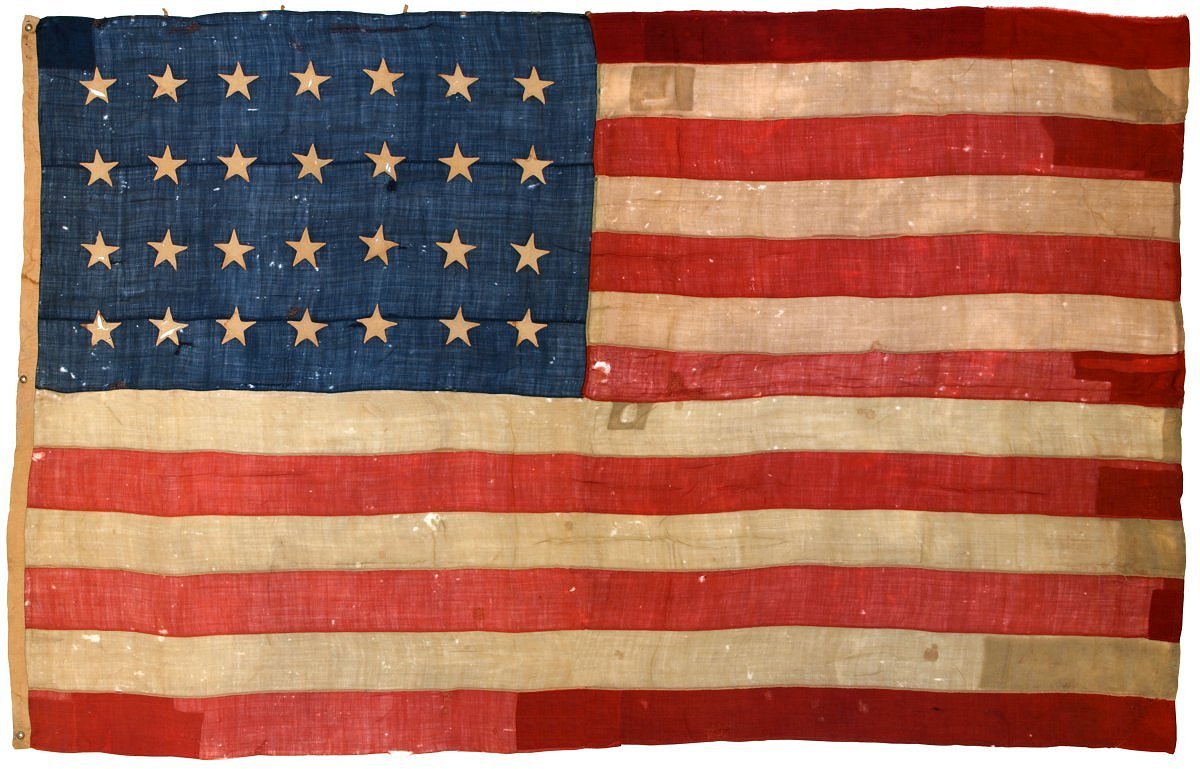|

This magnificent flag dates to the time of Texas
statehood circa 1846. There are several
characteristics of this flag that make it evident that
it was made for maritime use. The
size of the flag, style, and construction, being made of
wool bunting with single-appliqué cotton stars, is
consistent with other known ship's flags that pre-date
the Civil War. Of the few that survive, most are
very well maintained. They show evidence careful,
deliberate repairs, including darning, replaced fabric,
and reinforced patches. These flags weathered
years of use at sea under heavy winds and the most
severe conditions. They were made of the highest
quality wool bunting and materials. Inevitably,
though, they sustained losses and tears, some of which
resulted in entire portions of stripes to be replaced
with various pieces of fabric. Seeing the
multitude of repairs to this flag, one can imagine the
repeated episodes of wear and tear over many voyages at
sea. One
interesting type of repair that is common on many of
these ship's flags is the presence of double-reinforced
patches. You can see two of these types of patches
on this flag, at the top-center and center of the flag.
A similar patch is present on
IAS-00255, another early and rare ship's flag of 20
stars, dating to 1818.1
One curious aspect of this is the question of why these
same types of flags exhibit these same types of repairs.
I originally believed that the repairs were the
handiwork of sailors at sea, and that they learned the
repair techniques from other sailors in the course of their seaboard duty.
But what is more likely is that most repairs were made
in port. Once a ship arrived in port it would
undergo repairs and refitting ahead of the next voyage.
The ship's flags, which were extremely important and
costly items in a ship's inventory, would also have to
be repaired. Seamstresses in seafaring towns would
have done brisk business repairing clothing, sails and
ship's flags. They would have expertly repaired
tears by patching and darning them, and if necessary, by
replacing whole lengths of fabric with various materials
they had at hand. The flag's hoist does have crimped
brass grommets, and metal grommets weren't patented
until 1854, but the hoist itself is a sleeve hoist,
which is correct for the Mexican War period,
and the grommets were likely added to the hoist a few
years after the flag entered service, most likely during
one of the many times it was serviced in between
voyages. Flags
made prior to the Civil War are are very rare and those
with 28 stars, such as this flag, are virtually
non-existent. I'm aware of just four or five
surviving flags with 28 stars that date to the period of
Texas statehood on December 29, 1845. The count
was accurate for just 364 days. Its date also falls
firmly into the period of the Mexican War, 1846-1848,
which followed the annexation of Texas in 1845 under
President James Polk. Without question, this flag
is of the period, and is a beautiful and extremely rare
example of a pre-Civil War ship's flag that saw many
years of use at sea. 1
In May, 2012, a series of pre-Civil War naval flags
belonging to the USS Constitution, sold at Freeman's
Auctions in Philadelphia. Several of the flags, a
26 Star Commodore's Pennant, a 28 Star National Color,
and a 31 Star National Color, also exhibit the same type
of double-reinforced patchwork.
2 Period
writing on the hoist of this flag reads "S.T. Thuralay
Loaned by T.P.TUITE" and, in other period ink written at
a different time, "508 W. 145ST Manhattan". For
this reason, I believe the flag is more likely a
commercial maritime flag rather than a navy flag. |

